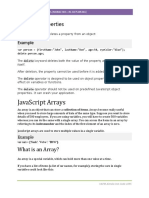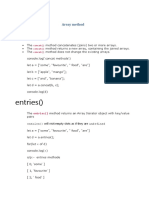8 Arrays (ShreeNotes)
Uploaded by
Viddesh Shravge8 Arrays (ShreeNotes)
Uploaded by
Viddesh ShravgeThe Arrays Object
The Array object lets you store multiple values in a single
variable. It stores a fixed-size sequential collection of
elements of the same type. An array is used to store a
collection of data, but it is often more useful to think of an
array as a collection of variables of the same type.
There are 3 ways to construct array in JavaScript
1. By array literal
2. By creating instance of Array directly (using new keyword)
3. By using an Array constructor (using new keyword)
1) Array literal
The syntax of creating array using array literal is given below:
var arrayname=[value1,value2.....valueN];
As you can see, values are contained inside [ ] and separated
by , (comma).Advertisement
Let's see the simple example of creating and using array in
JavaScript.
<script>
var emp=["Sonoo","Vimal","Ratan"];
for (i=0;i<emp.length;i++){
document.write(emp[i] + "<br/>");
}
</script>
The .length property returns the length of an array.
Output of the above example
Sonoo
Vimal
Ratan
2) Array directly (new keyword)
The syntax of creating array directly is given below:
var arrayname=new Array();
Here, new keyword is used to create instance of array.
Let's see the example of creating array directly.
<script>
var i;
var emp = new Array();
emp[0] = "Arun";
emp[1] = "Varun";
emp[2] = "John";
for (i=0;i<emp.length;i++){
document.write(emp[i] + "<br>");
}
</script>
Output of the above example
Arun
Varun
John
3) Array constructor (new keyword)
Here, you need to create instance of array by passing
arguments in constructor so that we don't have to provide
value explicitly.
The example of creating object by array constructor is given
below.
<script>
var emp=new Array("Jai","Vijay","Smith");
for (i=0;i<emp.length;i++){
document.write(emp[i] + "<br>");
}
</script>
Output of the above example
Jai
Vijay
Smith
Array length Property
The array length property in JavaScript is used to set or
return the number of elements in an array.
Syntax:
It is used to set the array length.
array.length = number
It returns the length of the array.
array.length
Return Value:
It returns a numerical value, denoting the number of
elements in the array object
Below is an example of the Array length property.
Example:
This example returns the length of the array.
function array() {
let colors = ["green", "blue", "red",
"yellow", "black", "white"];
console.log(colors.length);
}
array();
Output
6
More example codes for the above property are as follows:
Example 1:
• Javascript
let arr = new Array("Geeks", "for", "Geeks");
console.log("arr.length:" + arr.length);
Output:
arr.length:3
Example 2:
• Javascript
let arr = new Array(5, 10, 15);
console.log("arr.length:" + arr.length);
Output:
arr.length:3
Array Methods
concat()
The JavaScript Array concat() Method is used to merge two
or more arrays together. This method does not alter the
original arrays passed as arguments but instead, returns a
new Array.
Syntax:
let newArray1 = oldArray.concat()
let newArray2 = oldArray.concat(value0)
let newArray3 = oldArray.concat(value0,value1)
.......
let newArray = oldArray.concat(value1 , [ value2, [ ...,[
valueN]]])
Parameters: The parameters of this method are the arrays or
the values that need to be added to the given array. The
number of arguments to this method depends upon the
number of arrays or values to be merged.
Return value: This method returns a newly created array that
is created after merging all the arrays passed to the method
as arguments.
Example 1
Below is an example of the Array concat() method to join
three arrays.
// JavaScript code for concat() method
function func() {
let num1 = [11, 12, 13],
num2 = [14, 15, 16],
num3 = [17, 18, 19];
console.log(num1.concat(num2, num3));
}
func();
Output
[11, 12, 13, 14, 15,16, 17, 18, 19]
Example 2
In this example, the method concat() concatenates all the
arguments passed to the method with the given array into
one array which it returns as the answer.
// JavaScript code for concat() method
function func() {
let alpha = ["a", "b", "c"];
console.log(alpha.concat(1, [2, 3]));
}
func();
Output
[ 'a', 'b', 'c', 1, 2, 3 ]
Example 3:
In this example, the method concat() concatenates both
arrays into one array which it returns as the answer.
// JavaScript code for concat() method
function func() {
let num1 = [[23]];
let num2 = [89, [67]];
console.log(num1.concat(num2));
}
func();
Output
[ [ 23 ], 89, [ 67 ] ]
fill()
Method fills a given range of array elements with the given
value. This method is used to manipulate the existing array
according to our needs.
Syntax:
arr.fill(value,start,end)
Parameters:
• Value: Value to be filled.
• Start: Start index (included) and its default value is 0.
• End: End index (excluded) and its default index is this.length.
Return value: It returns the modified array.
Example 1:
In this example, we will fill an array with 0 starting from
an index at 2 till the end index of 4.
// input array contain some elements.
let array = [1, 2, 3, 4];
// Here array.fill function fills with 0
// from position 2 till position 3.
console.log(array.fill(0, 2, 4));
Output:
Array [1, 2, 0, 0]
Example 2:
In this example, we will fill the array with 9 starting from an
index at 2 till the end index of the array.
// input array contain some elements.
let array = [1, 2, 3, 4, 5, 6];
// Here array.fill function fill with
// 9 from position 2 till end.
console.log(array.fill(9, 2));
Output:
Array [1, 2, 9, 9, 9, 9]
Example 3:
In this example, we will fill the array completely with 6. This
is done by not giving the start and end index to the fill
method.
// input array contain some elements.
let array = [1, 2, 3, 4];
// Here array.fill function fill with
// 6 from position 0 till end.
console.log(array.fill(6));
Output:
Array [6, 6, 6, 6]
filter()
The JavaScript Array filter() Method is used to create a new
array from a given array consisting of only those elements
from the given array which satisfy a condition set by the
argument method.
Syntax:
array.filter(callback(element, index, arr), thisValue)
Parameters: This method accepts five parameters as
mentioned above and described below:
• callback: This parameter holds the function to be called for
each element of the array.
• element: The parameter holds the value of the elements
being processed currently.
• index: This parameter is optional, it holds the index of the
current element in the array starting from 0.
• arr: This parameter is optional, it holds the complete array on
which Array.every is called.
• thisValue: This parameter is optional, it holds the context to
be passed as this is to be used while executing the callback
function. If the context is passed, it will be used like this for
each invocation of the callback function, otherwise undefined
is used as default.
Return value: This method returns a new array consisting of
only those elements that satisfied the condition of
the arg_function.
Example 1:
In this example, the method filter() creates a new array
consisting of only those elements that satisfy the condition
checked by canVote() function.
// JavaScript to illustrate findIndex() method
function canVote(age) {
return age >= 18;
}
function func() {
let filtered = [24, 33, 16, 40].filter(canVote);
console.log(filtered);
}
func();
Output:
[24,33,40]
Example 2:
In this example, the method filter() creates a new array
consisting of only those elements that satisfy the condition
checked by isPositive() function.
function isPositive(value) {
return value > 0;
}
let filtered = [112, 52, 0, -1, 944].filter(isPositive);
console.log(filtered);
Output:
[112,52,944]
Example 3:
In this example, the method filter() creates a new array
consisting of only those elements that satisfy the condition
checked by isEven() function.
function isEven(value) {
return value % 2 == 0;
}
let filtered = [11, 98, 31, 23, 944].filter(isEven);
console.log(filtered);
Output:
[98,944]
find()
The Javascript arr.find() method in Javascript is used to get the
value of the first element in the array that satisfies the
provided condition. It checks all the elements of the array and
whichever the first element satisfies the condition is going to
print. This function will not work function having the empty
array elements and also does not change the original array.
Syntax:
array.find(function(currentValue, index, arr),thisValue);
Parameters: This method accepts 5 parameters as mentioned
above and described below:
• function: It is the function of the array that works on each
element.
• currentValue: This parameter holds the current element.
• index: It is an optional parameter that holds the index of the
current element.
• arr: It is an optional parameter that holds the array object to
which the current element belongs to.
• thisValue: This parameter is optional. If a value is to be
passed to the function to be used as its “this” value else the
value “undefined” will be passed as its “this” value.
Return value: It returns the array element value if any of the
elements in the array satisfy the condition, otherwise it
returns undefined.
We will understand the concept of the Javascript Array
find() method through the examples.
Example 1:
The below example illustrates the JavaScript Array
find() method to find a positive number.
// Input array contain some elements.
let array = [-10, -0.20, 0.30, -40, -50];
// Method (return element > 0).
let found = array.find(function (element) {
return element > 0;
});
// Printing desired values.
console.log(found);
Output:
0.3
Example 2:
Here, the arr.find() method in JavaScript returns the value of
the first element in the array that satisfies the provided testing
method.
// Input array contain some elements.
let array = [10, 20, 30, 40, 50];
// Method (return element > 10).
let found = array.find(function (element) {
return element > 20;
});
// Printing desired values.
console.log(found);
Output:
30
Example 3:
In this example, whenever we need to get the value of the
first element in the array that satisfies the provided testing
method at that time we use arr.find() method in JavaScript.
// Input array contain some elements.
let array = [2, 7, 8, 9];
// Provided testing method (return element > 4).
let found = array.find(function (element) {
return element > 4;
});
// Printing desired values.
console.log(found);
Output:
7
flat()
The Javascript arr.flat() method was introduced in ES2019. It
is used to flatten an array, to reduce the nesting of an array.
The flat() method is heavily used in the functional
programming paradigm of JavaScript. Before
the flat() method was introduced in JavaScript, various
libraries such as underscore.js were primarily used.
Syntax:
arr.flat([depth])
Parameters: This method accepts a single parameter as
mentioned above and described below:
• depth: It specifies, how deep the nested array should be
flattened. The default value is 1 if no depth value is passed as
you guess it is an optional parameter.
Return value: It returns an array i.e. depth levels flat than the
original array, it removes nesting according to
the depth levels.
Below is an example of the Array flat() method.
Example 1
In this example, we will see the basic implementation of the
Array flat() method.
// Creating multilevel array
const numbers = [['1', '2'], ['3', '4',
['5',['6'], '7']]];
const flatNumbers= numbers.flat(Infinity);
console.log(flatNumbers);
Output
[ '1', '2', '3','4', '5', '6','7']
Example 2
The following code snippet shows, how the
Array flat() method works.
let nestedArray = [1, [2, 3], [[]],
[4, [5]], 6];
let zeroFlat = nestedArray.flat(0);
console.log(
`Zero levels flattened array: ${zeroFlat}`);
// 1 is the default value even
// if no parameters are passed
let oneFlat = nestedArray.flat(1);
console.log(
`One level flattened array: ${oneFlat}`);
let twoFlat = nestedArray.flat(2);
console.log(
`Two level flattened array: ${twoFlat}`);
// No effect when depth is 3 or
// more since array is already
// flattened completely.
let threeFlat = nestedArray.flat(3);
console.log(
`Three levels flattened array: ${threeFlat}`);
Output
Zero levels flattened array: 1,2,3,,4,5,6
One level flattened array: 1,2,3,,4,5,6
Two level flattened array: 1,2,3,4,5,6
Three levels flattened array: 1,2,3,4,5,6
Note: For depth greater than 2, the array remains the same,
since it is already flattened completely.
Example 3
We can also remove empty slots or empty values in an array
by using the flat() method.
let arr = [1, 2, 3, , 4];
let newArr = arr.flat();
console.log(newArr);
Output
[ 1, 2, 3, 4 ]
forEach()
The arr.forEach() method calls the provided function once for
each element of the array. The provided function may
perform any kind of operation on the elements of the given
array.
Syntax:
array.forEach(callback(element, index, arr), thisValue)
Parameters: This method accepts five parameters as
mentioned above and described below:
• callback: This parameter holds the function to be called for
each element of the array.
• element: The parameter holds the value of the elements
being processed currently.
• index: This parameter is optional, it holds the index of the
current value element in the array starting from 0.
• array: This parameter is optional, it holds the complete array
on which Array.every is called.
• thisArg: This parameter is optional, it holds the context to be
passed as this is to be used while executing the callback
function. If the context is passed, it will be used like this for
each invocation of the callback function, otherwise undefined
is used as default.
Return value: The return value of this method is always
undefined. This method may or may not change the original
array provided as it depends upon the functionality of the
argument function.
Example 1
In this example, the Array.forEach() method is used to copy
every element from one array to another.
// JavaScript to illustrate forEach() method
function func() {
// Original array
const items = [12, 24, 36];
const copy = [];
items.forEach(function (item) {
copy.push(item + item+2);
});
console.log(copy);
}
func();
Output
[ 26, 50, 74 ]
Example 2:
In this example, the method forEach() calculates the square
of every element of the array.
// JavaScript to illustrate forEach() method
function func() {
// Original array
const items = [1, 29, 47];
const copy = [];
items.forEach(function (item) {
copy.push(item * item);
});
console.log(copy);
}
func();
Output
[ 1, 841, 2209 ]
includes()
The Javascript array.includes() method is used to know
whether a particular element is present in the array or not
and accordingly, it returns true or false i.e, if the element is
present, then it returns true otherwise false.
Syntax:
array.includes(searchElement, start)
Parameters: This method accepts two parameters as
mentioned above and described below:
• searchElement: This parameter holds the element which will
be searched.
• start: This parameter is optional and it holds the starting
point of the array, where to begin the search the default
value is 0.
Return Value: It returns a Boolean value i.e., either True or
False.
Below is an example of the Array includes() method.
Example:
In this example, we will see if a value is included in an array
or not using the Array includes() method.
let name = ['gfg', 'cse', 'geeks', 'portal'];
a = name.includes('gfg')
// Printing result of includes()
console.log(a);
Output:
true
The below examples illustrate the Array includes() method in
JavaScript:
Example 1:
In this example, the method will search for element 2 in that
array.
// Taking input as an array A
// having some elements.
let A = [1, 2, 3, 4, 5];
// includes() method is called to
// test whether the searching element
// is present in given array or not.
a = A.includes(2)
// Printing result of includes().
console.log(a);
Output:
True
Example 2:
In this example, the method will search for the element ‘cat’
in that array and returns false as ‘cat’ is not present in the
array.
// Taking input as an array A
// having some elements.
let name = ['gfg', 'cse', 'geeks', 'portal'];
// includes() method is called to
// test whether the searching element
// is present in given array or not.
a = name.includes('cat')
// Printing result of includes()
console.log(a);
Output:
false
Array indexOf()
The JavaScript Array indexOf() Method is used to find the
index of the first occurrence of the search element provided
as the argument to the method. This method always
compares the search element to the element present in the
array using strict equality. Therefore, when the search
element is NaN then it returns -1 because NaN values are
never compared as equal.
Syntax:
array.indexOf(element, start)
Parameters: This method accepts two parameters as
mentioned above and described below:
• element: This parameter holds the element whose index will
be returned.
• start: This parameter is optional and it holds the starting
point of the array, where to begin the search the default
value is 0.
Return value: This method returns the index of the first
occurrence of the element. If the element cannot be found in
the array, then this method returns -1.
Example 1:
Below is an example of the Array indexOf() method.
let name = ['gfg', 'cse', 'geeks', 'portal'];
a = name.indexOf('gfg')
// Printing result of method
console.log(a)
Output
0
Example 2:
In this example, the method will be searched for element 2
in that array and return that element index.
// Taking input as an array A
// having some elements.
let A = [1, 2, 3, 4, 5];
// indexOf() method is called to
// test whether the searching element
// is present in given array or not.
a = A.indexOf(2)
// Printing result of method.
console.log(a);
Output
1
Example 3:
In this example, the method will be searched for element 9 in
that array if not found then return -1.
// Taking input as an array A
// having some elements.
let name = ['gfg', 'cse', 'geeks', 'portal'];
// indexOf() method is called to
// test whether the searching element
// is present in given array or not.
a = name.indexOf('cat')
// Printing result of method
console.log(a);
Output
-1
Array join()
The JavaScript Array join() Method is used to join the
elements of an array into a string. The elements of the string
will be separated by a specified separator and its default
value is a comma(, ).
Syntax:
array.join(separator)
Parameters: This method accepts a single parameter as
mentioned above and described below:
• separator: It is Optional i.e, it can be either used as a
parameter or not. Its default value is a comma(, ).
•
Example 1:
In this example, the function join() joins together the
elements of the array into a string using ‘|’.
function func() {
let a = [1, 2, 3, 4, 5, 6];
console.log(a.join('|'));
}
func();
Output:
1|2|3|4|5|6
Example 2:
In this example, the function join() joins together the
elements of the array into a string using ‘, ‘ since it is the
default value.
let a = [1, 2, 3, 4, 5, 6];
console.log(a.join());
Output
1,2,3,4,5,6
Example 3:
In this example, the function join() joins together the
elements of the array into a string using ‘ ‘ (empty string).
let a = [1, 2, 3, 4, 5, 6];
console.log(a.join(''));
Output:
123456
Array lastIndexOf()
The JavaScript Array lastIndexOf() Method is used to find the
index of the last occurrence of the search element provided
as the argument to the function.
Syntax:
array.lastIndexOf(element, start)
Parameters: This method accepts two parameters as
mentioned above and described below:
• element: This parameter holds the element whose index will
be returned.
• start: This parameter is optional and it holds the starting
point of the array, where to begin the search the default
value is 0.
Return value: This method returns the index of the last
occurrence of the element. If the element cannot be found in
the array, then this method returns -1.
Below is an example of the Array lastIndexOf() method.
Example:
let name = ['gfg', 'cse', 'geeks', 'portal'];
a = name.lastIndexOf('gfg')
// Printing result of method
console.log(a);
Output:
0
Example 1
In this example, the method will be searched for element 2 in
that array and return that element index.
// Taking input as an array A
// having some elements.
let A = [1, 2, 3, 4, 5];
// lastIndexOf() method is called to
// test whether the searching element
// is present in given array or not.
a = A.lastIndexOf(2)
// Printing result of method.
console.log(a);
Output:
1
Example 2:
In this example, the method will search for the element 9 in
that array if not found then return -1.
// Taking input as an array A
// having some elements.
let name = ['gfg', 'cse', 'geeks', 'portal'];
// lastIndexOf() method is called to
// test whether the searching element
// is present in given array or not.
a = name.lastIndexOf('cat')
// Printing result of method
console.log(a);
Output:
-1
Array pop()
The JavaScript Array pop() Method is used to remove the last
element of the array and also returns the removed element.
This function decreases the length of the array.
Syntax:
arr.pop()
Parameters: This method does not accept any parameter.
Return value This method returns the removed element
array. If the array is empty, then this function returns
undefined.
Below is an example of the Array pop() method.
Example 1:
function func() {
let arr = ['GFG', 'gfg', 'g4g', 'GeeksforGeeks'];
// Popping the last element from the array
console.log(arr.pop());
}
func();
Output:
GeeksforGeeks
Example 2:
In this example, the pop() method removes the last element
from the array, which is 4, and returns it.
function func() {
let arr = [34, 234, 567, 4];
// Popping the last element from the array
let popped = arr.pop();
console.log(popped);
console.log(arr);
}
func();
Output:
4
34,234,567
Example 3
In this example, the function pop() tries to extract the last
element of the array but since the array is empty therefore it
returns undefined as the answer.
function func() {
let arr = [];
// popping the last element
let popped = arr.pop();
console.log(popped);
}
func();
Output:
undefined
Array push()
The JavaScript Array push() Method is used to add one or
more values to the end of the array. This method changes the
length of the array by the number of elements added to the
array.
Syntax:
arr.push(element0, element1, … , elementN)
Parameters: This method contains as many numbers of
parameters as the number of elements to be inserted into
the array.
Return value: This method returns the new length of the
array after inserting the arguments into the array.
Below is an example of the Array push() method.
Example 1:
function func() {
let arr = ['GFG', 'gfg', 'g4g'];
// Pushing the element into the array
arr.push('GeeksforGeeks');
console.log(arr);
}
func();
Output:
GFG,gfg,g4g,GeeksforGeeks
Example 2:
In this example, the function push() adds the numbers to the
end of the array.
function func() {
// Original array
let arr = [34, 234, 567, 4];
// Pushing the elements
console.log(arr.push(23, 45, 56));
console.log(arr);
}
func();
Output:
7
34,234,567,4,23,45,56
Example 3:
In this example, the function push() adds the objects to the
end of the array.
function func() {
// Original array
let arr = [34, 234, 567, 4];
// Pushing the elements
console.log(arr.push('jacob', true, 23.45));
console.log(arr);
}
func();
Output:
7
34,234,567,4,jacob,true,23.45
Array reverse()
JavaScript Array.reverse() Method is used for the in-place
reversal of the array. This method reverses the order of the
array. The first element of the array becomes the last
element and the last one becomes the first. It mutates the
original array. We can also use the Array.toReversed() which
returns the new array with the elements in the reverse order.
Syntax:
arr.reverse()
Parameters: This method does not accept any parameter
Return value: This method returns the reference of the
reversed original array.
Example 1:
The below examples illustrate the JavaScript Array reverse()
Method
function func() {
// Original Array
let arr = ['Portal', 'Science',
'Computer', 'GeeksforGeeks'];
console.log(arr);
// Reversed array
let new_arr = arr.reverse();
console.log(new_arr);
}
func();
Output
[ 'Portal', 'Science', 'Computer', 'GeeksforGeeks' ]
[ 'GeeksforGeeks', 'Computer', 'Science', 'Portal' ]
Example 2:
In this example, the reverse() method reverses the sequence
of the array elements of arr.
function func() {
// Original Array
let arr = [34, 234, 567, 4];
console.log(arr);
// Reversed array
let new_arr = arr.reverse();
console.log(new_arr);
}
func();
Output
[ 34, 234, 567, 4 ]
[ 4, 567, 234, 34 ]
Array shift()
The JavaScript Array shift() Method removes the first
element of the array thus reducing the size of the original
array by 1.
Syntax:
arr.shift()
Parameters: This method does not accept any parameter.
Return value: This function returns the removed first element
of the array. If the array is empty then this function returns
undefined.
Note: This function can also be used with other javascript
objects that behave like the array.
Below is an example of the Array shift() method.
Example 1:
In this example, the shift() method removes the first string
element of the array, therefore it returns GFG.
function func() {
// Original array
let array = ["GFG", "Geeks", "for", "Geeks"];
// Checking for condition in array
let value = array.shift();
console.log(value);
console.log(array);
}
func();
Output:
GFG
Geeks, for, Geeks
Example 2:
In this example, the shift() method removes the first element
of the array, therefore it returns 34.
function func() {
// Original array
let array = [34, 234, 567, 4];
// Checking for condition in array
let value = array.shift();
console.log(value);
console.log(array);
}
func();
Output:
34,234,567,4
Example 3:
In this example, the shift() method tries to remove the first
element of the array, but the array is empty, therefore it
returns undefined.
function func() {
// Original array
let array = [];
// Checking for condition in array
let value = array.shift();
console.log(value);
console.log(array);
}
func();
Output:
undefined
Array slice()
The Javascript arr.slice() method returns a new array
containing a portion of the array on which it is implemented.
The original remains unchanged.
Syntax:
arr.slice(begin, end)
Parameters: This method accepts two parameters as
mentioned above and described below:
• begin: This parameter defines the starting index from where
the portion is to be extracted. If this argument is missing then
the method takes begin as 0 as it is the default start value.
• end: This parameter is the index up to which the portion is to
be extracted (excluding the end index). If this argument is not
defined then the array till the end is extracted as it is the
default end value If the end value is greater than the length
of the array, then the end value changes to the length of the
array.
Return value: This method returns a new array containing
some portion of the original array.
Below is an example of the Array slice() method.
Example 1:
In this example, the slice() method extracts the array from
the given array starting from index 2 and including all the
elements less than index 4.
function func() {
// Original Array
let arr = [23, 56, 87, 32, 75, 13];
// Extracted array
let new_arr = arr.slice(2, 4);
console.log(arr);
console.log(new_arr);
}
func();
Output:
[23,56,87,32,75,13]
[87,32]
Example 2
In this example, the slice() method extracts the entire array
from the given string and returns it as the answer, Since no
arguments were passed to it.
function func() {
//Original Array
let arr = [23, 56, 87, 32, 75, 13];
//Extracted array
let new_arr = arr.slice();
console.log(arr);
console.log(new_arr);
}
func();
Output:
[23,56,87,32,75,13]
[23,56,87,32,75,13]
Example 2:
In this example, the slice() method extracts the array starting
from index 2 till the end of the array and returns it as the
answer.
function func() {
//Original Array
let arr = [23, 56, 87, 32, 75, 13];
//Extracted array
let new_arr = arr.slice(2);
console.log(arr);
console.log(new_arr);
}
func();
Output:
[23,56,87,32,75,13]
[87,32,75,13]
Array sort()
JavaScript Array.sort() Method is used to sort the array in
place in a given order according to the compare() function. If
the method is omitted then the array is sorted in ascending
order.
Syntax:
arr.sort(compareFunction)
Parameters: This method accepts a single parameter as
mentioned above and described below:
• compareFunction: This parameter is used to sort the
elements according to different attributes and in a different
order.
• compareFunction(a,b) < 0
• compareFunction(a,b) > 0
• compareFunction(a,b) = 0
Return value: This method returns the reference of the
sorted original array.
Example 1:
// JavaScript to illustrate sort() function
function func() {
// Original string
let arr = ["Geeks", "for", "Geeks"]
console.log(arr);
// Sorting the array
console.log(arr.sort());
}
func();
Output:
Geeks,for,Geeks
Geeks,Geeks,for
Example 2
In this example, the sort() method arranges the elements of
the array in ascending order.
// JavaScript to illustrate sort() function
function func() {
//Original string
let arr = [2, 5, 8, 1, 4]
//Sorting the array
console.log(arr.sort());
console.log(arr);
}
func();
Output:
1,2,4,5,8
1,2,4,5,8
Example 3:
In this example, the sort() method the elements of the array
are sorted according to the function applied to each element.
// JavaScript to illustrate sort() function
function func() {
// Original array
let arr = [2, 5, 8, 1, 4];
console.log(arr.sort(function (a, b) {
return a + 2 * b;
}));
console.log(arr);
}
func();
Output:
2,5,8,1,4
2,5,8,1,4
Example 3:
In this example, we use the sort() method on the array of
numbers & observe some unexpected behavior.
let numbers = [20, 5.2, -120, 100, 30, 0]
console.log(numbers.sort())
Output:
-120,0,100,20,30,5.2
Array splice()
The JavaScript Array splice() Method is an inbuilt method in
JavaScript that is used to modify the contents of an array by
removing the existing elements and/or by adding new
elements.
Syntax:
Array.splice( index, remove_count, item_list )
Parameter: This method accepts many parameters some of
which are described below:
• index: It is a required parameter. This parameter is the index
from which the modification of the array starts (with the
origin at 0). This can be negative also, which begins after
many elements counting from the end.
• remove_count: The number of elements to be removed from
the starting index.
• items_list: The list of new items separated by a comma
operator that is to be inserted from the starting index.
Return Value: While it mutates the original array in place, still
it returns the list of removed items. In case there is no
removed array it returns an empty array.
Below are examples of the Array splice() method:
Example 1:
let webDvlop = ["HTML", "CSS", "JS", "Bootstrap"];
console.log(webDvlop);
// Add 'React_Native' and 'Php' after removing 'JS'.
let removed = webDvlop.splice(2, 1, 'PHP',
'React_Native')
console.log(webDvlop);
console.log(removed);
// No Removing only Insertion from 2nd
// index from the ending
webDvlop.splice(-2, 0, 'React')
console.log(webDvlop)
Output:
HTML,CSS,JS,Bootstrap
HTML,CSS,PHP,React_Native,Bootstrap
JS
HTML,CSS,PHP,React,React_Native,Bootstrap
Example 2:
Here is another example of the Array splice() method.
let languages = ['C++', 'Java', 'Html', 'Python', 'C'];
console.log(languages);
// Add 'Julia' and 'Php' after removing 'Html'.
let removed = languages.splice(2, 1, 'Julia', 'Php')
console.log(languages);
console.log(removed);
// No Removing only Insertion from 2nd index from
the ending
languages.splice(-2, 0, 'Pascal')
console.log(languages)
Output:
C++,Java,Html,Python,C
C++,Java,Julia,Php,Python,C
Html
C++,Java,Julia,Php,Pascal,Python,C
Array toString()
The JavaScript Array toString() Method returns the string
representation of the array elements
Syntax:
arr.toString()
Parameters: This method does not accept any parameter.
Return value:
• The method returns the string representation of the array
elements.
• If the array is empty, then it returns an empty string.
• The original array is not changed by this method
Below is an example of the Array toString() method.
Example 1:
// JavaScript to illustrate toString() method
function func() {
// Original array
let arr = ["Geeks", "for", "Geeks"];
// Creating a string
let str = arr.toString();
console.log(str);
}
func();
Output:
Geeks,for,Geeks
Example 2:
In this example, the toString() method creates a string
consisting of array elements.
// JavaScript to illustrate toString() method
function func() {
// Original array
let arr = [2, 5, 8, 1, 4];
// Creating a string
let str = arr.toString();
console.log(str);
}
func()
Output:
2,5,8,1,4
Array unshift()
The JavaScript Array unshift() Method is used to add one or
more elements to the beginning of the given array. This
function increases the length of the existing array by the
number of elements added to the array.
Syntax:
array.unshift(element1, element2, ..., elementX)
Parameters: This method accepts a single parameter.
• element: This parameter element is to be added at the
beginning of the array.
Return value: This function returns the new length of the
array after inserting the arguments at the beginning of the
array.
Example 1:
Below is an example of the Array unshift() method.
function func() {
// Original array
let array = ["GFG", "Geeks", "for", "Geeks"];
// Checking for condition in array
let value = array.unshift("GeeksforGeeks");
console.log(value);
console.log(array);
}
func();
Output
5
[ 'GeeksforGeeks', 'GFG', 'Geeks', 'for', 'Geeks' ]
Example 2:
In this example, the function unshift() adds 28 and 65 to the
front of the array.
function func() {
let arr = [23, 76, 19, 94];
// Adding elements to the front of the array
console.log(arr.unshift(28, 65));
console.log(arr);
}
func();
Output
6
[ 28, 65, 23, 76, 19, 94 ]
Example 3: In this example, the unshift() method tries to
add the element of the array, but the array is empty
therefore it adds the value in the empty array.
function func() {
let arr = [];
console.log(arr.unshift(1));
}
func();
Output
1
You might also like
- Must To Know Array Methods in Javascript - DEV Community ? ?? ? PDFNo ratings yetMust To Know Array Methods in Javascript - DEV Community ? ?? ? PDF1 page
- Javascript (JS) Data Structures: ArraysNo ratings yetJavascript (JS) Data Structures: Arrays34 pages
- Lecture-3 Loops, Arrays, Function and Object-3267 (1) - 3795No ratings yetLecture-3 Loops, Arrays, Function and Object-3267 (1) - 379515 pages
- JavaScript Array Methods - Shiksha OnlineNo ratings yetJavaScript Array Methods - Shiksha Online10 pages
- Bandwidth Extension of High Compliance Current MirNo ratings yetBandwidth Extension of High Compliance Current Mir9 pages
- W10 Vibrating Wire V-Notch Weir Monitor SystemNo ratings yetW10 Vibrating Wire V-Notch Weir Monitor System4 pages
- STDIX-Unit4-IntroductiontoGenerativeAIExercise(2024-25)No ratings yetSTDIX-Unit4-IntroductiontoGenerativeAIExercise(2024-25)6 pages
- Information Sheet 1.5-1 Training ResourcesNo ratings yetInformation Sheet 1.5-1 Training Resources4 pages
- Vehicle Breakdown Assistance Management System Praveen S and TeamNo ratings yetVehicle Breakdown Assistance Management System Praveen S and Team55 pages
- Electrical Diagram Deck Crane (DRAW-SUPPL - 4000132 - 1 - A01) - 180% (5)Electrical Diagram Deck Crane (DRAW-SUPPL - 4000132 - 1 - A01) - 111 pages
- Chatbot Utilization For Medical Consultant System: Nudtaporn Rosruen and Taweesak SamanchuenNo ratings yetChatbot Utilization For Medical Consultant System: Nudtaporn Rosruen and Taweesak Samanchuen5 pages
- Information Assurance Security in the Information Environment 2nd edition by Andrew Blyth, Gerald Kovacich ISBN 1846282667 978-1846282669 download100% (1)Information Assurance Security in the Information Environment 2nd edition by Andrew Blyth, Gerald Kovacich ISBN 1846282667 978-1846282669 download47 pages

























































































